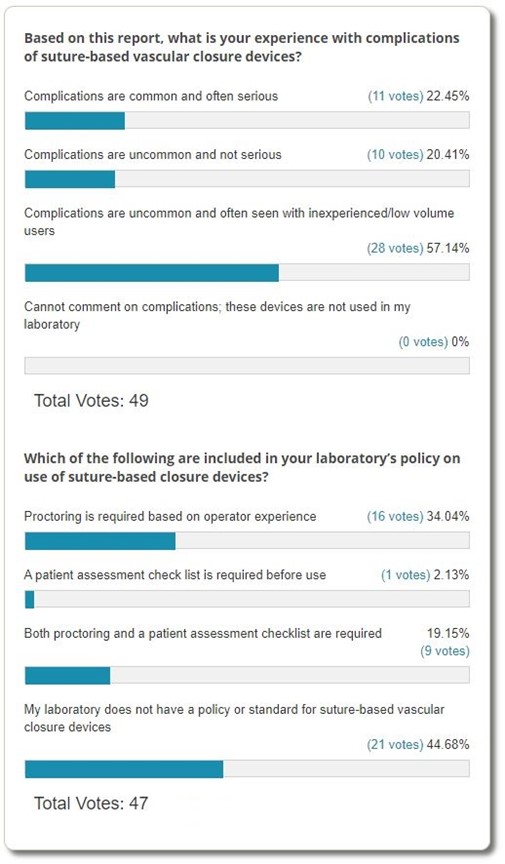Poll Results: Suture-Based Vascular Closure Devices
Quick Takes
- Significant complications have been reported related to use of suture-based femoral vascular closure devices.
- Patient selection and operator training are likely significant causes of device failure.
- Enhanced initial training and/or retraining as needed represent useful opportunities to improve outcomes, particularly in the setting of increasing radial procedures.
A recently published review1 of reports of complications of suture-based vascular closure devices from the US Food & Drug Administration MAUDE (Manufacturer and User Facility Device Experience) post-marketing surveillance database identified 827 reports of major complications with Perclose ProGlide (Abbott Cardiovascular; Abbott Park, IL) and 175 reports of major complications with Prostar XL (Abbott Cardiovascular; Abbott Park, IL). Actual injury occurred in 404 Perclose ProGlide complications and 94 Prostar XL complications, including 1 death in each group. Complications included failure to deploy, bleeding, hematoma, and device failure, including suture or deployment issues. The authors conclude that appropriate patient selection and operator training are important components of safe use of these devices.
A parallel article by Davies et al.2 provides training guidance for high-risk percutaneous coronary intervention with proposed core competencies. The authors suggest that trainees perform at least 100 ultrasound-guided, femoral-access procedures to ensure competency in access and closure management. This new focus on femoral access is in part a result of the increase use of radial access in practice, which often leaves trainees with limited femoral experience, which may further increase the risk of femoral access.3 This phenomenon, often termed the "Campeau Radial Paradox," reflects higher risk outcomes due to limited training or loss of skills over time when predominant radial operators perform femoral access. Thus, a practice of training or retraining is an opportunity to limit femoral access and closure complications, particularly when utilizing sophisticated closure devices.
This poll's results show that just over half of respondents feel that, although uncommon, suture-based closure complications most commonly occur in the hands of low volume and/or inexperienced operators. Approximately a third of labs require proctoring based on operator experience, but nearly half of the respondents' labs have no standard or policy related to suture-based closure devices. Given less frequent use of femoral access, policies related to monitoring and training or retraining in femoral access and closure management appears to be an opportunity to improve outcomes with the suture-based closure devices.

References
- Case BC, Kumar S, Yerasi C, et al. Real-world experience of suture-based closure devices: Insights from the FDA Manufacturer and User Facility Device Experience. Catheter Cardiovasc Interv 2021;Feb 4:[Epub ahead of print].
- Davies RE, Prasad M, Alaswad K, et al. Training in high-risk coronary procedures and interventions: Recommendations for core competencies. Catheter Cardiovasc Interv 2020;Sept 11:[Epub ahead of print].
- Azzalini L, Tosin K, Chabot-Blanchet M, et al. The Benefits Conferred by Radial Access for Cardiac Catheterization Are Offset by a Paradoxical Increase in the Rate of Vascular Access Site Complications With Femoral Access: The Campeau Radial Paradox. JACC Cardiovasc Interv 2015;8:1854-64.
Clinical Topics: Invasive Cardiovascular Angiography and Intervention, Noninvasive Imaging, Interventions and Imaging, Echocardiography/Ultrasound
Keywords: Vascular Closure Devices, Patient Selection, Ultrasonography, Sutures, Percutaneous Coronary Intervention, Hematoma, Policy, Product Surveillance, Postmarketing, Ultrasonography, Interventional, Equipment Failure, Pharmaceutical Preparations, United States Food and Drug Administration
< Back to Listings
